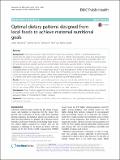| dc.description.abstract | Background: Achieving nutritional requirements for pregnant and lactating mothers in rural households while
maintaining the intake of local and culture-specific foods can be a difficult task. Deploying a linear goal programming
approach can effectively generate optimal dietary patterns that incorporate local and culturally acceptable diets. The
primary objective of this study was to determine whether a realistic and affordable diet that achieves nutritional goals
for rural pregnant and lactating women can be formulated from locally available foods in Tanzania.
Methods: A cross sectional study was conducted to assess dietary intakes of 150 pregnant and lactating women using
a weighed dietary record (WDR), 24 h dietary recalls and a 7-days food record. A market survey was also carried out to
estimate the cost per 100 g of edible portion of foods that are frequently consumed in the study population. Dietary
survey and market data were then used to define linear programming (LP) model parameters for diet optimisation. All
LP analyses were done using linear program solver to generate optimal dietary patterns.
Results: Our findings showed that optimal dietary patterns designed from locally available foods would improve
dietary adequacy for 15 and 19 selected nutrients in pregnant and lactating women, respectively, but inadequacies
remained for iron, zinc, folate, pantothenic acid, and vitamin E, indicating that these are problem nutrients (nutrients
that did not achieve 100% of their RNIs in optimised diets) in the study population.
Conclusions: These findings suggest that optimal use of local foods can improve dietary adequacy for rural pregnant
and lactating women aged 19–50 years. However, additional cost-effective interventions are needed to ensure
adequate intakes for the identified problem nutrients. | en_US |

